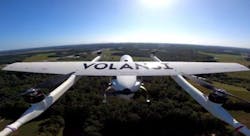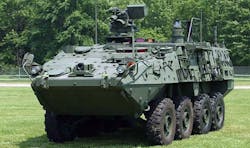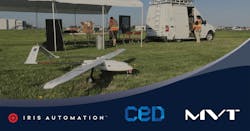Commercial healthcare drone delivery service in North Carolina, USA
In this week’s roundup from the Association for Unmanned Vehicle Systems International, which highlights some of the latest news and headlines in unmanned vehicles and robotics, commercial healthcare drone deliveries, biological and chemical reconnaissance vehicle development for the U.S. Army, and Canada increases permissions for beyond visual line of sight drone flights.
Volansi launches commercial healthcare drone delivery project in North Carolina
Volansi Inc. has launched a commercial healthcare drone delivery project in North Carolina.
In collaboration with pharmaceutical company Merck, Volansi is testing the delivery of cold chain medicines from Merck's Wilson, North Carolina manufacturing site to Vidant Healthplex-Wilson, a Vidant Health clinic, as the first of three phases in a project to learn about how drone technology can improve access to healthcare.
Accessing care in Eastern North Carolina can be challenging because of its vast and rural environment. During initial flights in the project, the first drone delivery of temperature-controlled medicines within the U.S were made.
“We've seen the world's supply chain strained like never before from the impact of Coronavirus,” explains Hannan Parvizian, CEO and co-founder of Volansi.
“There's now an accelerated need for rapid advancements in supply chain technology, especially in healthcare. Drone delivery is one solution to getting critical supplies where they are needed, at the moment they are needed most.”
Volansi's all-electric VOLY C10 drone is being used during the project. Capable of carrying 10-pounds of cargo to locations up to 50 miles away, the VOLY C10’s vertical take-off and landing (VTOL) system allows it to deliver fragile cargo with a “soft touch” automated release once the drone has landed at the delivery location. Requiring minimal infrastructure to operate, the VTOL system can deliver on the returning flight items to support order confirmation like temperature trackers and shipping confirmation.
“As a healthcare leader, Merck is very supportive of collaborations using new technologies to explore how one day we could help better serve the healthcare community,” says Craig Kennedy, senior vice president, Global Supply Chain Management, Merck.
“Our existing distribution system is strong, and this pilot helps us explore new innovative delivery options that would complement our existing supply chain capabilities.”
To ensure that its deliveries are made safely and in accordance with state and federal guidelines, Volansi is working with the UAS Integration Pilot Program (IPP) and the North Carolina Department of Transportation (NCDOT). For phases two and three of the project, the company will seek additional approval from the FAA to provide deliveries in additional locations, which will enable a flexible, on-demand, and responsive supply of critical medicines.
FLIR Systems awarded $26 million contract modification in support of NBCRV SSU program for U.S. Army
In support of the Nuclear, Biological and Chemical Reconnaissance Vehicle Sensor Suite Upgrade (NBCRV SSU) program for the U.S. Army, FLIR Systems has been awarded a $26 million contract modification.
As a follow-on to a $48 million contract announced in April 2019, the Other Transaction Authority (OTA) agreement was awarded through the Joint Program Executive Office for Chemical, Biological, Radiological, and Nuclear Defense (JPEO-CBRND).
The lead integrator in modernizing the Army’s NBCRV system with improved and autonomous CBRN sensors, FLIR delivered initial prototypes of the NBCRV SSU system earlier this year for a focused assessment at Fort Bliss, Texas. The FLIR prototype was used by soldiers in realistic battlefield scenarios to sense and rapidly avoid CBRN hazards.
Through the new contract, FLIR will continue developing the Sensor Suite and to deliver mature prototypes for government testing in 2021.
Among other third-party solutions, the NBCRV Sensor Suite will feature capabilities of the FLIR R80D SkyRaider drone equipped with a specialized version of the FLIR IBAC bio-detection sensor.
To expand the system’s use with manned-unmanned teams, the NBCRV will be paired with a ground robotic vehicle during the next phase. A FLIR-developed command and control system will bring together all devices and platforms with sensor fusion and automation features that reduce the cognitive burden on users and improve decision-making.
“Our ability to build and integrate manned and unmanned sensing solutions across a wide threat space is where FLIR differentiates itself,” says Vice President and General Manager of the Unmanned Systems & Integrated Solutions business at FLIR, Roger Wells.
“Incorporating UAV and UGV platforms into NBCRV aligns with our efforts to develop full sensing capabilities that can act as force multipliers and boost mission success for our troops.
FLIR is supporting other efforts by JPEO-CBRND. The company has won two contracts worth more than $55 million in the last year to field its FLIR Agentase C2 chemical warfare disclosure spray, which is formulated to detect nerve agents like VX and sarin, as well as blister agents such as sulfur mustard
Work on the NBCRV program has begun and is expected to continue through 2022 at FLIR facilities in West Lafayette, Indiana; Stillwater, Oklahoma; and Elkridge, Maryland.
Iris Automation, partners granted Special Flight Operations Certificate for BVLOS UAS flights in uncontrolled airspace
Transport Canada has issued the second Special Flight Operations Certificate (SFOC) for Beyond Visual Line of Sight (BVLOS) flights in uncontrolled airspace. The flights will utilize infrastructure masking and Iris Automation’s onboard detect-and-avoid (DAA) solution to MVT Geo-solutions.
Under this SFOC, MVT, the UAS Center of Excellence (CED Alma), and Iris Automation will work together to conduct commercial missions over linear power lines in Alma, Quebec. Under the approval, Iris Automation's DAA system, Casia, will be used. Casia provides commercial drones with automated collision avoidance maneuvers.
“This permission further demonstrates how the Casia onboard detect-and-avoid (DAA) system is helping to advance the safety case for drone usage while simultaneously expanding the envelope of drone-related use cases,” says Jon Damush, CEO of Iris Automation.
“Drones offer tremendous promise in terms of safety and economics as compared to piloted aviation alternatives, but we must integrate them into the airspace safely. Seeing and avoiding other aircraft is paramount to that safety, and steps like this are key to unlocking the promise of drones.”
According to Iris Automation, these flights will mark the partnership’s first BVLOS flights outside of the CED Alma test range that will leverage onboard DAA for air risk mitigation and does not require ground-based visual observers or radar. It is the second BVLOS waiver the partnership has secured in Canada. The first waiver was limited to flights within the Center of Excellence’s controlled airspace.
“Obtaining this Special Flight Operations Certificate (SFOC) is a first in Quebec,” says Alain Fortin, president of the UAS Center of Excellence.
“As a Canadian pioneer in the civil and commercial RPAS industry, Alma’s CED is proud to have contributed to the development of technologies and skills that speed up the advent of safe and well-integrated BVLOS flight in Canadian airspace.”
The companies say that the resulting flight missions from this approval will help inform more complex commercial operations in the future.
Compiled by Brian Sprowl, Associate Editor, AUVSI
Share your vision-related news by contacting Dennis Scimeca, Associate Editor, Vision Systems Design
SUBSCRIBE TO OUR NEWSLETTERS


